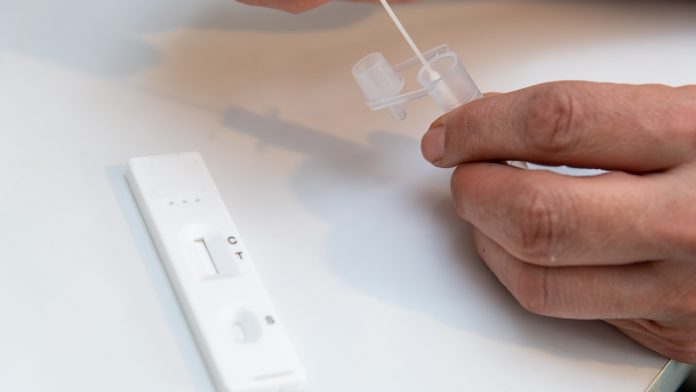
The UK Health Security Agency (UKHSA) has confirmed that a PCR test is no longer required to confirm coronavirus if a positive lateral flow device (LFD) is received.
This will be a temporary measure whilst COVID-19 rates remain high across the UK. Whilst levels of COVID-19 are high, the majority of people with a positive LFD result can be confident that they have COVID-19 without the need to complete a PCR test.
This new approach will be implemented from 11 January 2022 in England.
Confirming results without a PCR test
Lateral flow tests are taken by people who do not have COVID-19 symptoms. Anyone who develops a symptom of COVID-19 is being advised to continue to stay at home and self-isolate and take a PCR test. They must self-isolate if they get a positive test result, even if the lateral flow test was negative. These rules remain in place.
The news follows similar changes made in January 2021, where there was a high prevalence of COVID-19 infection, meaning it was likely that a positive LFD result was a true positive. This also resulted in confirmatory PCR tests being temporarily paused and then reintroduced in March 2021 once there was a clear reduction in infection rates.
The UK is leading in Europe with the largest testing programme with over 400 million tests carried out since the start of the pandemic. Furthermore, since December 2022, 100,000 more PCR test booking slots are available per day and capacity continues to rapidly expand, with delivery capacity doubled to 900,000 PCR and LFD test kits a day.
Revising the previous approach
Under this new approach, anyone who receives a positive LFD test result should report their result on GOV.UK and must self-isolate immediately but will not need to take a follow-up PCR test.
After reporting a positive LFD test result, they will be contacted by NHS Test and Trace so that their contacts can be traced and must continue to self-isolate.
There are a few exceptions to this revised approach:
- People who are eligible for the £500 Test and Trace Support Payment (TTSP) will still be asked to take a confirmatory PCR if they receive a positive LFD result, to enable them to access financial support,
- People participating in research or surveillance programmes may still be asked to take a follow-up PCR test according to the research or surveillance protocol,
- Around one million people in England who are at particular risk of becoming seriously ill from COVID-19 have been identified by the NHS as being potentially eligible for new treatments. They will be receiving a PCR test kit at home by mid-January to use if they develop symptoms or if they get a positive LFD result, as they may be eligible for new treatments if they receive a positive PCR result. This group should use these priority PCR tests when they have symptoms as it will enable prioritised laboratory handling.
In addition to the reduced self-isolation approach announced on 22 December, anyone who tests positive will be able to leave self-isolation seven days after the date of their initial positive test if they receive two negative LFD results, 24 hours apart, on days six and seven.
Secretary of State for Health and Social Care Sajid Javid said: “We have built a world-leading testing system and our testing capacity is the largest in Europe. This has helped save lives and protect millions of people from COVID-19. It forms a crucial line of defence alongside vaccines and antivirals.
“As Omicron cases continue to rise, the demand for tests has grown rapidly across the globe. We’re putting plans in place to manage the demand for PCR tests in the UK so we can ensure that those who most need tests can continue to access them.”
Chief Executive of UKHSA, Dr Jenny Harries, said: “While cases of COVID-19 continue to rise, this tried-and-tested approach means that LFDs can be used confidently to indicate COVID-19 infection without the need for PCR confirmation.
“It remains really important that anyone who experiences COVID-19 symptoms self-isolates immediately. They should also order a PCR test on GOV.UK or by phoning 119.
“I’m really grateful to the public and all of our critical workers who continue to test regularly and self-isolate when necessary, along with other practical and important public health behaviours, as this is the most effective way of stopping the spread of the virus and keeping our friends, families and communities safe.”








